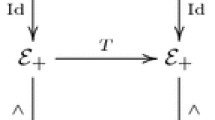Summary
Sharp space-time coordinatesx are replaced by stochastic space-time coordinatesX with meansx and dispersion measured by a universal lengthλ as the kinematical basis of Lorentz covariant field theories, classical or quantum. It is found that 4-dimensional distributions are not possible, but 3-dimensional (unsharp rods, sharp clocks) and 1-dimensional (unsharp clocks, sharp rods) distributions are allowed. We find that Lorentz invariance and the new feature of nonzero dispersion together imply that a given physical field be represented by an infinity of (in general, slightly different) tensor fields, one for each equivalent observer. Some consequences of this idea in quantum field theory are investigated. It results, generally speaking, in high momentum cut offs in some expressions. For free fields we remark that the invariant functions turn out continuous and bounded; a « skin effect» violation of microcausality is present in the exterior of the light cone. For interacting fields we mention only that the iteration solutionS-matrix is unambiguous (no subtraction formalism) and has only finite matrix elements. The renormalization idea that self energy parts, etc., only renormalize bare particle parameters must, strictly speaking, be given up. Correction to « point particle» scattering arise in the form of form factor functions of momentum transfersq. These arenot functions ofq 2 only, as in currentad hoc theories. The « standard deviation» λ is estimated as nucleon Compton wave length or smaller.
Riassunto
Si sostituiscono le coordinate spazio-temporali ben definitex con coordinate spaziotemporali stocasticheX, in oui lex medie e la dispersione sono misurate con una lunghezza universale λ, come base cinematica delle teorie di campo covarianti di Lorentz, classiche o quantistiche. Si trova che le distribuzioni quadridimensionali non sono possibili, mentre sono permesse le distribuzioni tridimensionali (regoli non ben definiti, orologi precisi) e unidimensionali (orologi non precisi, regoli ben definiti). Si trova che Finvarianza di Lorentz e la nuova proprietà della dispersione non nulla prese assieme implicano che un dato campo fisico sia rappresentato da un’infinità di campi tensoriali (in genere lievemente diversi), uno per eiaseuno osservatore équivalente. Si analizzano alcune delle conseguenze di quest’idea nella teoria quantistica dei campi. Essa produce, generalmente parlando, grandi cut-off dell’impulso in aleune espressioni. Per i campi liberi si nota che le funzioni invarianti risultano continue e limitate, una violazione della microcausalità per « skin effect « è presente all’esterno del cono di luce. Per campi interagenti si fa notare solo che la matrice8 della soluzione d’interazione è priva di ambiguità (senza formalismo sottrattivo) ed ha solo elementi di matrice finiti. Il concetto della rinormalizzazione, secondo il quale le parti dell’autoenergia, ecc., rinormalizzano solo i parametri della particella nuda, deve essere, strettamente parlando, abbandonata. Le correzioni allo scattering di « particelle puntiformi» assumono la forma di funzioni dei fattori di forma dei trasferimenti d’impulsoq. Questinon sono funzioni solo di g2, corne nelle usuali teoriead hoc. La « deviazione standard» λ si valuta come una lunghezza d’onda Compton del nucleone, o minore.
Similar content being viewed by others
References
A. Einstein:The Meaning of Relativity, 4th ed. (Princeton, 1953).
N. Bogoliubov andD. Shirkov:Introduction to the Theory of Quantized Fields (New York, 1959), Sect. 19.1.
R. Hofstadter:Ann. Rev. Nucl. Sci.,7, 231 (1957).
A. Wightman:Suppl. Nuovo Cimento,14, 81 (1959).
Bogoliubov andShirkov: op. cit., Sect. 16.8.
W. Thirring:Einführung in die Quantenelektrodynamik, (Wien, 1955), Teil 1, Sect. 1.
Here we follow closely the development inJ. Jauch andE. Rohrlich:The Theory of Photons and Electrons (Cambridge, 1955)
D. Yennie, M. Lèvy andD. Ravenhall:Rev. Mod. Phys.,29, 144 (1957).
Author information
Authors and Affiliations
Rights and permissions
About this article
Cite this article
Ingraham, R.L. Stochastic Lorentz observers and the divergences in quantum field theory. Nuovo Cim 24, 1117–1146 (1962). https://doi.org/10.1007/BF02754294
Received:
Published:
Issue Date:
DOI: https://doi.org/10.1007/BF02754294



